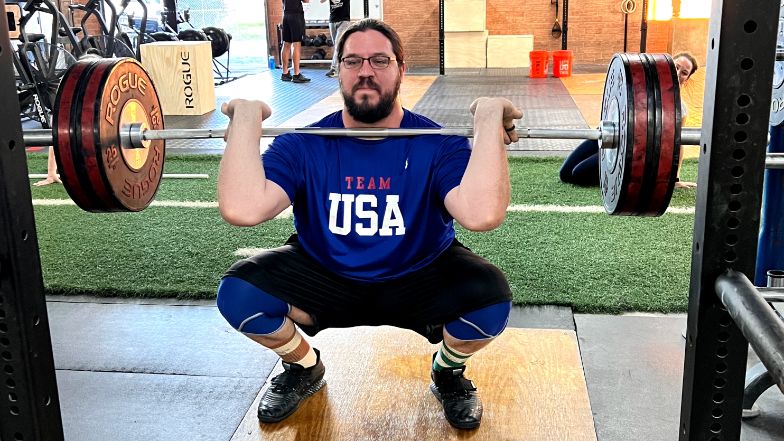We test and review fitness products based on an independent, multi-point methodology. If you use our links to purchase something, we may earn a commission. Read our disclosures.
When it comes to squats, we like to think that there is one exact way to perform a proper squat, but that is not always the case. Sure, there are some common cues that a coach can use about squatting stance width or depth in the squat, but the simple fact is that not everyone squats the same. In strength training, no two people will squat exactly the same, due to squat anatomy—factors like skeletal structure and biomechanics—and that’s okay.
Today we’re taking a dive into the world of squat anatomy, going into the nitty gritty of the bones, muscles, and joints involved in squatting. Furthermore, we will talk about how certain anatomical differences from person to person will impact their squat positions. Lastly, we will talk about equipment and exercises that can help you based on your anatomy and biomechanics. We’re going to learn a lot about the body’s makeup during the squat, no “bones” about it!
Ok, now that I’ve gotten my pun out of the way…
Key Points on How to Squat
Let’s recap what we are looking for in a squat. Whether it’s a barbell back squat or you’re squatting with only your bodyweight as resistance, there are certain main points I like to coach my athletes through.
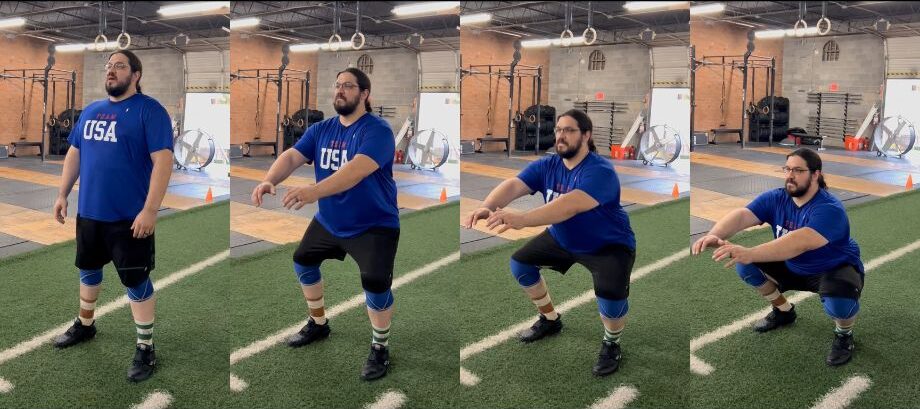
- Starting stance: For the squat exercise, we typically want the feet about shoulder-width apart with the toes pointed slightly outward in our standing position. We want our weight distributed evenly through the foot; almost think of the foot having three even points of contact: the heel, and both the big toe and pinky toe. This helps us keep the whole foot planted and prevents us from rolling the ankle inward or outward too much.
- Braced torso: We want to ensure a strong, tight core and torso during the squat. In order to brace properly, we want a neutral spine, having the abdominals and posterior chain tight and active at the start. As we lower, we want to remember to maintain this rigid position by keeping the chest up.
- Upright position: As we begin to lower in the squat by shifting the hips back, it’s important to keep the chest upright and shoulders back throughout the movement. How upright we are depends on our mechanics, as some athletes may have a more pronounced forward lean in their squat. We’ll discuss this aspect later on.
- Tracking knees: The knees should track over the toes during a squat which means that, if the toes are slightly pointed outward, the knees should move outward as well.
- Low depth: For an experienced lifter with no injuries, we want our squats below parallel, meaning the athlete’s hip crease moves below the knees. How deep you can truly get into a squat, however, will depend on some differing factors, such as femur and torso length (more on that in a bit). Also, if you are new to squats, you may need to train and progress into a full range of motion on your squats.
It’s important to remember that these general guidelines are just that: general. One person’s proper squat technique is going to look a little different from another’s squat technique. And even though we want to think about performing each squat variation the same, one person’s squats may differ from variation to variation—like a back squat to a front squat—due to limiting factors and anatomy.
Squat Anatomy
There are a lot of moving parts in a squat, and that should come as no surprise; the human body is a wonderfully complex machine. Here is a breakdown of the main parts involved in the squat mechanics of the lower body.
Upper Limb
The upper limb of the leg consists of the thigh bone, or femur, and the pelvis. The head of the femur is shaped like a ball, and connects to the socket of the pelvis, called the acetabulum, creating a ball-and-socket joint with a wide range of motion in a variety of directions and angles.
The hip joint is connected to many muscles, including the lower back erectors and abdominal muscles, but also the upper leg muscles, including the quadriceps on the front of the femur, and the hamstrings on the posterior of the femur. Above the hamstrings are the glutes—including the gluteus maximus—which, along with the hamstrings and low back, comprise the posterior chain muscles.
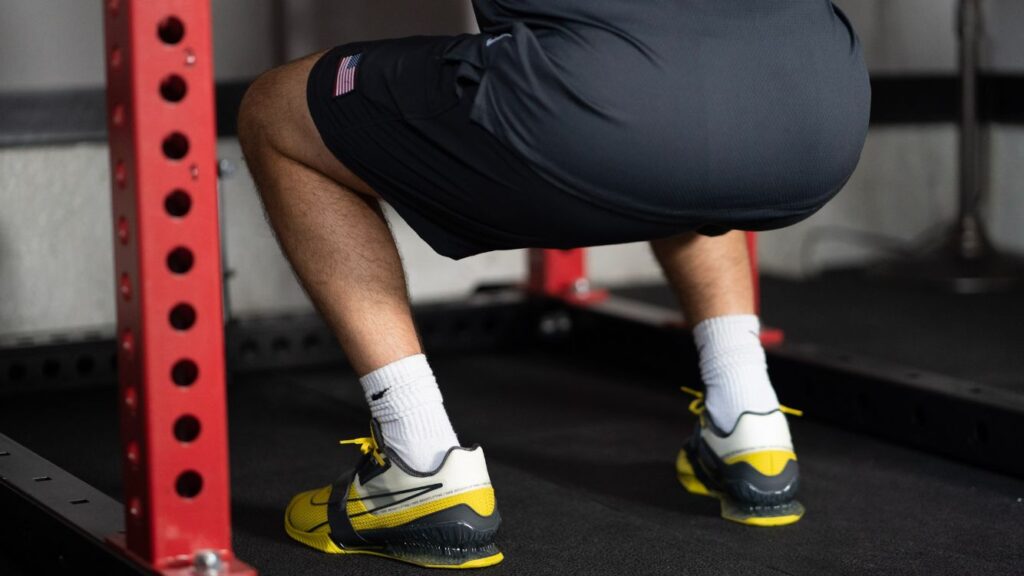
Hip flexion is executed by a group of muscles called the hip flexors— which includes the iliacus, psoas, pectineus, rectus femoris, and sartorius—while the adductor and abductor muscles, and the glutes, are primarily responsible for internal and external rotation.
Lower Limb
In the lower limb, we have the tibia and fibula connecting from the knee joint to the ankle. The tibia is the shin bone and is the larger of the two bones, and the fibula is the smaller one that sits posteriorly to the tibia. The tibia supports most of your bodyweight here, but the fibula is vital in stabilizing the tibia.
The major muscle groups here are the calves, known as the gastrocnemius, which has two muscle heads connected to the femur, and then connects to the Achilles tendon in the ankle. This, in conjunction with the soleus, helps with dorsiflexion and plantar flexion—lifting the foot and toes up and down.
Knee Joint
Both the femur and tibia connect at the knee, a hinge joint in the leg, responsible for moving the lower leg back and forth. Knee flexion happens when the hamstrings contract and the quads extend; the opposite happens for knee extension.
Main Factors in the Squat Position
Now that we’ve broken down the general mechanics of the human body during a squat, let’s take a look at how these factors differentiate one lifter’s squat from another.
Hip Socket
One of the greatest biomechanical factors in a squat deals with the hip socket, and how the femur’s head connects into the acetabulum. The socket’s depth and angle, along with the femur heads’ shape and angle, can determine how wide and rotated of a stance you need while squatting.
Because we don’t always have X-rays readily available to determine what kind of hip joint we have, it’s best to judge this from how a squat feels. Depending on how the femur meets the pelvis will determine if you feel more comfortable in a narrow stance or wide stance, with the toes pointed outward more or less than another.
Femur Length
Another major factor that will determine your squatting style is the length of the femur in relation to the rest of your body. Someone with a short femur and long torso will tend to look upright in their squat; it’s a textbook squat. Usually these people will move effortlessly, bouncing right out of one squat to the next.
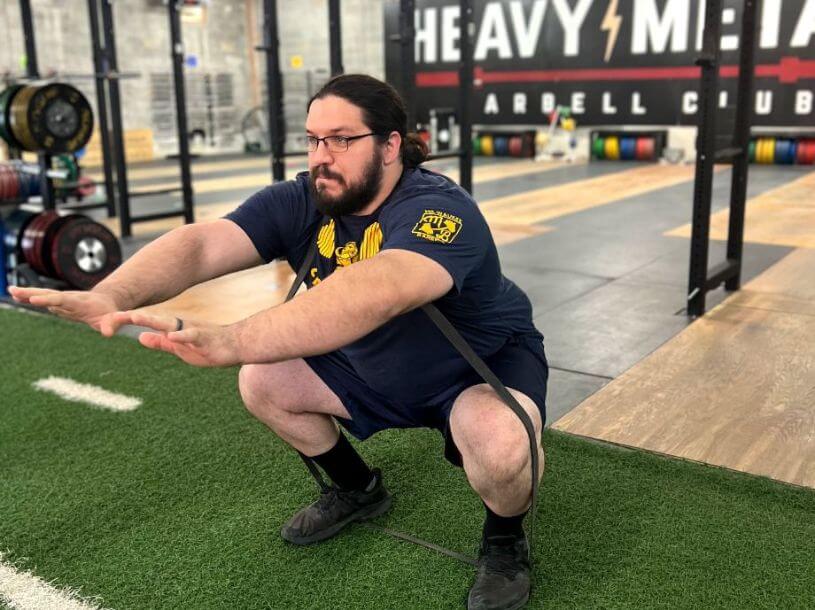
On the other hand, someone with long femurs tends to squat with a wider stance with a more of a forward lean at the bottom of the squat. No amount of mobility work will make them squat more upright; it’s just the biomechanics. The longer femur shifts the hips back more and the torso has to counterbalance by leaning forward.
Low-Bar vs High-Bar Positions
People have preferences between low-bar and high-bar squat variations—how high or low you place the bar on a back squat. Some of this might have to do with biomechanics. Someone who can stay more upright on a squat will prefer a narrow, high-bar squat stance, while people who have more of a lean will rely more on hip flexion and a low-bar position.
A study from 20191 showed that a narrow squat stance had greater knee flexion when compared to a wider stance. This is typical of a high-bar squat, generally performed with a more narrow stance, and relying more on the knees. Likewise, a wide stance is more beneficial to a low-bar position, where the greater flexion is in the hip instead of the knee.
Ankle Mobility
In an October 2021 study,2 it was found that biomechanics of the legs during squats correlated with joint flexibility and relative muscle strength more than leg length proportions. Overall joint flexibility and mobility is very important when it comes to how you squat, particularly with the hip and ankle joint.
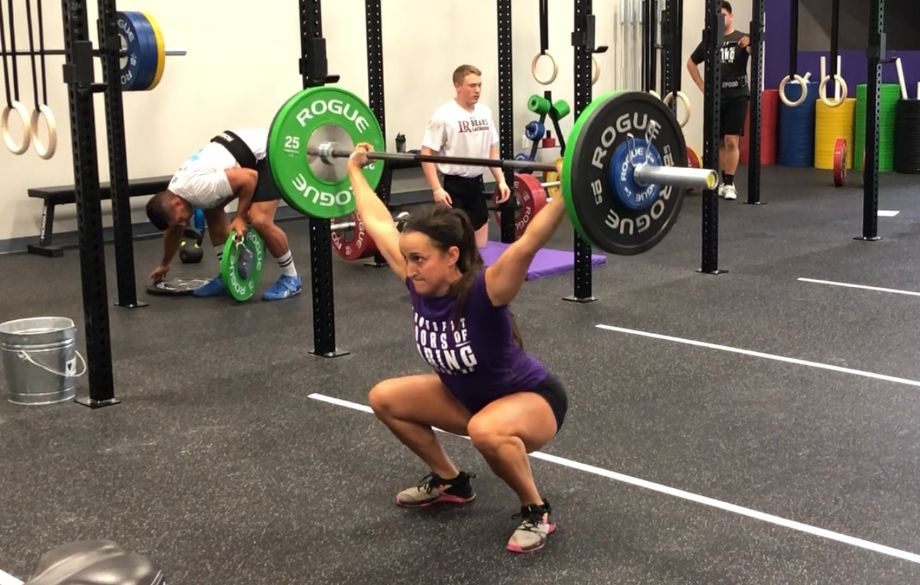
Ankle dorsiflexion will determine how far your knees will track over your feet and toes. People with ridiculous ankle mobility can look like they are sitting down on top of their heels, while those with very little mobility will have their shins almost perpendicular to the floor in the bottom of a squat. Most of us will probably be somewhere in between.
Lacking ankle mobility can be another reason powerlifters favor a wider, low-bar stance. A 2018 study3 found that a wide stance could be beneficial for a lifter with limited ankle dorsiflexion, as the wider squat limited the angles of joints in the squat.
Thoracic Mobility
How mobile you are in the upper body can have an impact on how you squat as well. I particularly have had experience with my thoracic cage, which is pretty immobile for an Olympic weightlifter, affecting my squat. While this doesn’t show up too bad in a back or front squat, I have a pretty significant forward lean during overhead squats. Having a tight trunk that doesn’t bend or extend well can cause some differences in your squat form as well.
Working On Your Squats
As I said before, we are all made with varying limb lengths and levels of strength and mobility, so we won’t squat exactly the same. However, there are some technical aspects of the squat that we want to hit, and there are plenty of ways to help improve your own unique squat style.
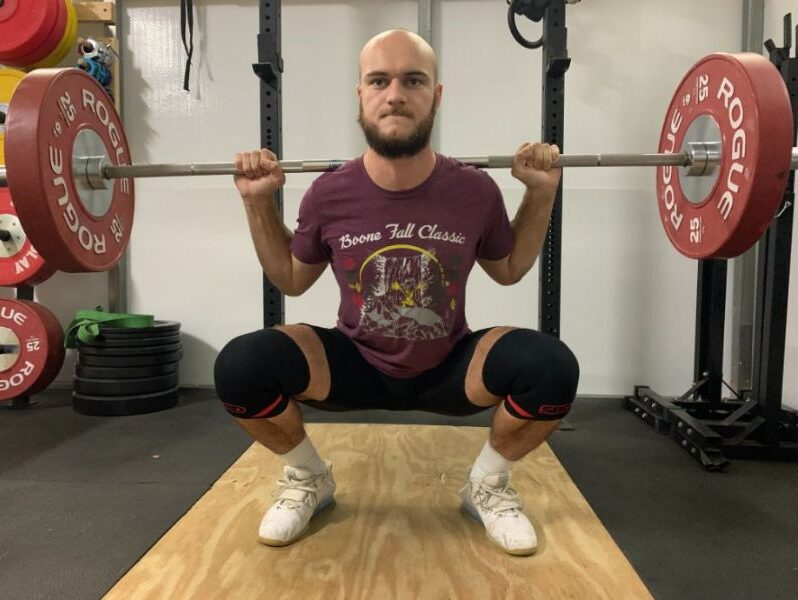
Mobility Work
The areas that are vital in a squat are the hip joint and the ankle joint. If you are tight in one of these areas, it’s smart to work on stretching them out. Get the hips with a pigeon stretch or couch stretch, and you stretch the calves out with a deep lunge.
Also, make sure your upper body is not causing you too many issues. Roll out the upper back to make it a little more mobile, and keep the shoulders loose, as they must be able to grip the bar properly in a back squat or front squat. If you’re not sure which exercises to do, it’d be a good idea to talk to a physical therapist about what mobility exercises you’d benefit from most.
Squat Progressions
There are a few ways to progress and vary your squats, and for several reasons. Here’s a couple:
- Box squats: If you are struggling to squat below parallel, a box squat is a great progression, where you squat to a target: the box. You can set the box height to a level you are comfortable with. Over time, you can slowly lower that box height to parallel and then eventually, a below-parallel squat.
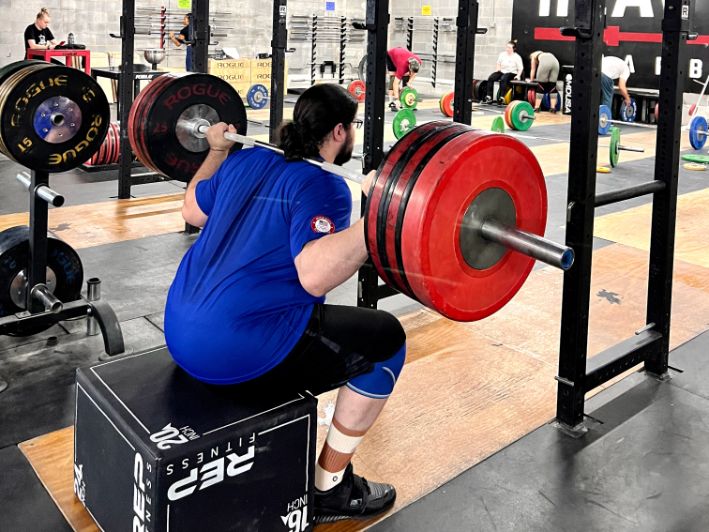
- Safety bar squats: These squats are done with a safety squat bar, and they are great for someone lacking the mobility to grab a bar properly for a back squat or front squat. The handles are at the front of the bar, allowing for comfort in the arms gripping the bar. Ideally, we want to gain the mobility to grip the bar correctly, but this is a good way to get a proper squat workout in while you’re working on it.
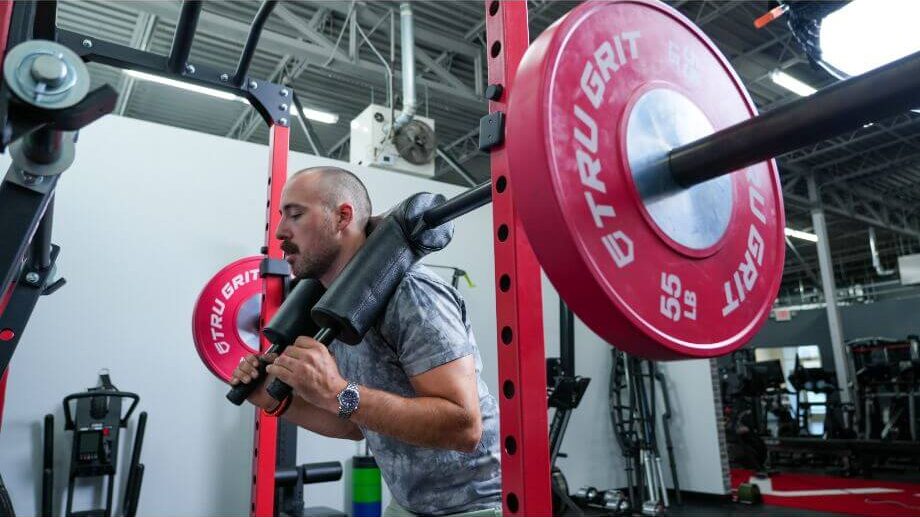
- Split squats: For someone who is noticing imbalances between their legs, unilateral work can help balance out these issues. Single-leg squats, often known as Bulgarian split squats, are done by propping one leg on a bench behind you, then squatting with the forward leg on the floor. This will isolate one leg at a time, allowing to work on those imbalances.
- Squat jumps: Squat jumps are a variation of squats, where you explosively jump out of the bottom of your squat and land on the ground to begin your next squat. Not only are they a great exercise for developing explosive strength and power, but the fluid rebound of the ankle upon landing back into a squat can help improve flexibility in the ankle.
Use of Equipment
Along with squat progressions, there are some pieces of gym equipment that can help address issues during a squat.
- Weightlifting shoes: Of the equipment I’m talking about right now, this is 100% the most important. Weightlifting shoes help put you in a more natural squatting position by having a higher heel-toe-drop, usually between 0.75 and 1.25 inches. This can help combat tight ankles and allow the knees to shift a little more forward in the squat. Additionally, the sole is incredibly stable, allowing for a solid foundation in your lifting.
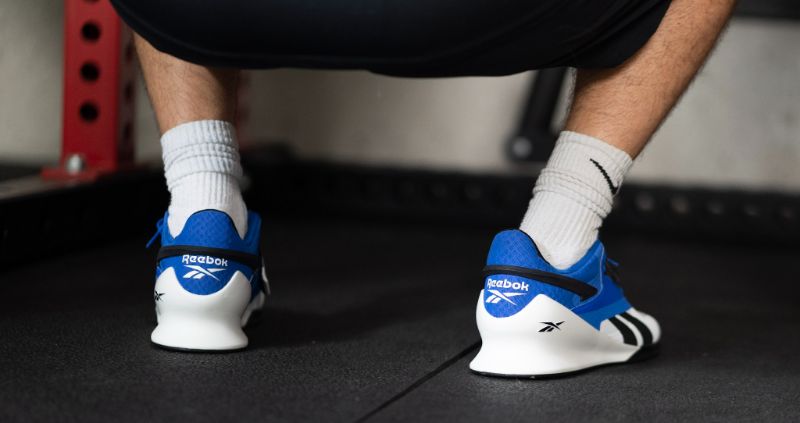
- Hip circles: If you tend to let the knees cave in—known as knee valgus—it could be from weak ankles rolling in or weak leg muscles in general. A nice tactile cue to fight this is wrapping a light hip circle around the thighs just above the knees. During a squat, you’ll be reminded to push the knees outward by the slight resistance you’ll feel on your legs.
- Weightlifting belts: Weightlifting belts will help give you a little bit of support in the torso and core, and help you to brace during heavy lifts. With that said, if you are newer to strength training, I recommend working on strengthening the core first before over-relying on a belt.
Squat Anatomy: Final Thoughts
While there are definitely some key aspects to squats that will be universal person to person (you don’t squat with your arms!), each person’s squat will be individualized for their needs, based on their biomechanics, experience level, and mobility.
- Biomechanics, like leg and torso length, can be a major player in how we squat, notably our squat depth and forward lean.
- Mobility can also determine things like our squat stance width and our depth.
- If you are having trouble with your squat, consider working on some mobility work and working through some squat progressions.
- Finally, get yourself some lifting shoes to give yourself a solid base, and then get in the gym and squat!
Squat Anatomy: Q&A
What anatomical movement is a squat?
A squat is performed by flexion of the hip and knee, and dorsiflexion of the ankle joints, down to a squat depth (preferably below parallel) and then extending the joints back to a standing position.
What are the three primary muscles used in the squat?
The three muscles primarily responsible for a squat are the quadriceps, hamstrings, and the glutes.
What is the function of a squat?
There are many uses of a squat. As an exercise, squats can help burn fat and build muscle, along with developing explosive strength. Read this article on the benefits of squats to learn more about all the different ways squats can benefit you.
References
- Lahti J, Hegyi A, Vigotsky AD, Ahtiainen JP. Effects of barbell back squat stance width on sagittal and frontal hip and knee kinetics. Scand J Med Sci Sports. 2019 Jan;29(1):44-54. doi: 10.1111/sms.13305. Epub 2018 Oct 11. PMID: 30230052.
- Kim S, Miller M, Tallarico A, Helder S, Liu Y, Lee S. Relationships between physical characteristics and biomechanics of lower extremity during the squat. J Exerc Sci Fit. 2021 Oct;19(4):269-277. doi: 10.1016/j.jesf.2021.09.002. Epub 2021 Oct 4. PMID: 34712337; PMCID: PMC8512761.
- Demers E, Pendenza J, Radevich V, Preuss R. The Effect of Stance Width and Anthropometrics on Joint Range of Motion in the Lower Extremities during a Back Squat. Int J Exerc Sci. 2018 Jun 1;11(1):764-775. PMID: 29997725; PMCID: PMC6033510.
Further reading

Ever wondered how to do one-arm dumbbell rows with proper form? Here you’ll get everything you need for good form. Read more

The Pallof press exercise just might be the best ab exercise you're not doing. Get the low down on the Pallof press straight from a personal trainer. Read more

Find out the best time to take maca root to maximize the purported energy, mood, and sexual health benefits. Read more

Try our 30-day pull-up progression plan specifically designed to be scalable for beginners and experienced lifters alike. Read more

